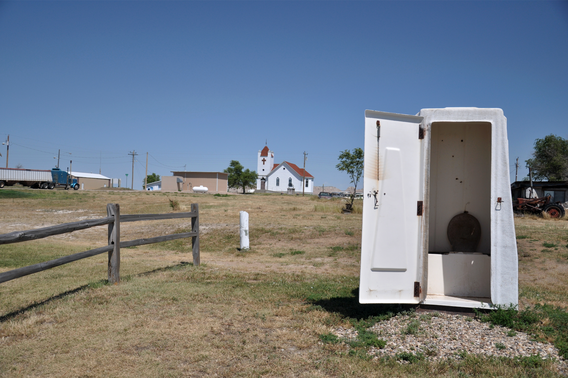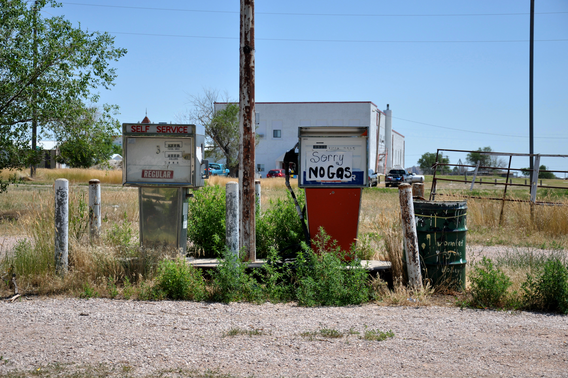CARINE & ELISABETH KRECKÉ
Dakotagate

In 2009, Elisabeth and I extensively cruised America on Google Street View. We checked endless miles of desert roads without ever seeing anything worth of interest. And then one day, unexpectedly, something happened within the boring Street View scenery: on the main street of a tranquil town in South Dakota, we encountered a man with a heavy assault weapon, flashing a glance to the camera lens of the passing Google car. This anecdotal event became the pretext for us to launch an on-site photographic investigation. Flying to South Dakota to "investigate" a man with rifle seen on the Internet, the idea may seem weird. After all, what does it mean to be witness to an event on a digital platform like Google Street View? Is it not to give undue importance to a trivial navigation tool? In order to cope with the issue, we decided to make a detour via fiction. With Google Street View, a war- or crime-related picture had been sent out to the world: that was our conjecture for Dakotagate.

Images © Carine Krecké, First Stop Guns, 501 7th Street, Rapid City, SD, 2010
Our tour began on July 10, 2010 at 7th Street, Rapid City, at the exact location where the Google picture had been taken. In minutes, we solved the riddle of the man with machine gun. No big surprise: a gun supermarket is next door. Obviously, the man is a regular customer of the store. A citizen who, as we were told, is exercising his constitutional right to carry a firearm...

This could have been the end of our inquiry. However, we decided it was not. We wanted to know more about that man walking the street with an assault weapon. We started drawing a map of firearm related acts or crimes in the area of Rapid City. After compiling data from all kinds of archives (police, justice department, local press...), we patrolled the area within a radius of approximately 100 miles. We documented the sites mentioned in the reports with photos and notes, in order to construct a sort of narrative map. Inevitably, we winded up in the Pine Ridge Indian Reservation, home of the Lakota Sioux, about a hundred miles south of Rapid City, a fascinating area, haunted by a series of unsolved crimes....

1 - The archive
(selection)
Dakotagate is an archive containing photographs we took onsite, interview transcripts and open source justice and police records of crimes committed in the area of interest

FBI documents and photos
Images © Carine Krecké, 2010 (unless specified otherwise)
Documents: police records (FBI), American Justice Department and other open-source files.
2- Trails + Trials
Drawings documenting events linked to the siege of Wounded Knee in the 1970's

Wounded Knee is a small cemetery and a memorial in the midst of the vast grasslands of Pine Ridge Indian reservation. Two major historical events had occurred in that place. First, in 1890, about three hundred Lakota people had been massacred on that spot by soldiers of the United States army. Second, in 1973, the site was occupied by a group of Oglala Sioux and followers of the American Indian Movement in protest against the treatment of Indian people in American culture and society. Federal military forces immediately encircled the community. The siege lasted 71 days. Several locals lost their lives. Trails + Trials is a series of 20 large-scale drawings (84 x 119 cm). The images are based on press photos that covered the 1973 incident as well as fragmental transcriptions of trials, judicial reports or legal cases in which some of the protagonists were involved. Creating drawings of scenes from political and/or judicial events linked to the Wounded Knee shoot-out was a way for us to recall the legitimate nature of these locals' fight against abuses and injustice. For this project, we chose the visual form of 1970s superhero comic-style drawing, precisely to highlight how difficult it can be to untangle the relationship between war and truth, decades after events took place.We had the chance to meet some of the surviving instigators of the 1973 Wounded Knee incident while we were on the Pine Ridge Indian reservation in the summer of 2010.

3 - The publication
Exhibition catalogue published by Nei Liicht Art Center, Luxembourg, 2012
Text and images : Carine & Elisabeth Krecké / Preface : Julie Fabre (in French)
Mise en page: Bunkerpalace
ISBN-10 2-91993-27-5
Exhibition at Nei Liicht Art Center, Luxembourg, 2012
Curator: Danièle Igniti
Project supported by:
Aide à la publication, FOCUNA, Luxembourg
Bourse d'Aide à la Création, Centre National de l'Audiovisuel, 2012
Ville de Dudelange
























